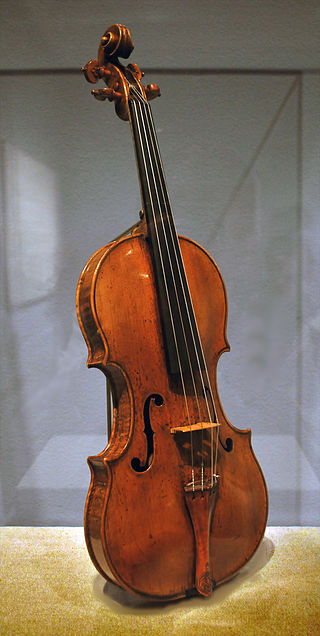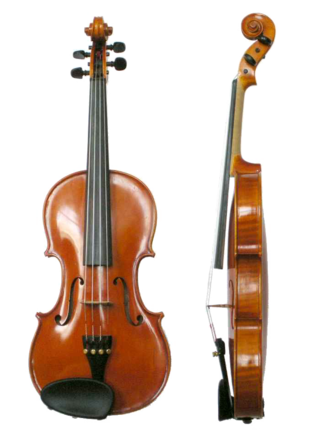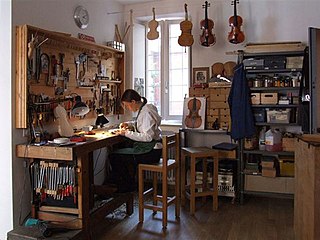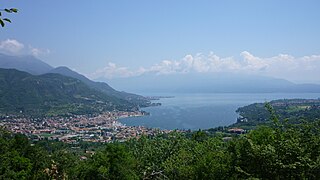Related Research Articles

Amati is the last name of a family of Italian violin makers who lived at Cremona from about 1538 to 1740. Their importance is considered equal to those of the Bergonzi, Guarneri, and Stradivari families. Today, violins created by Nicolò Amati are valued at around $600,000. Because of their age and rarity, Amati instruments are mostly kept in museum or private collections and are seldom played in public.

The violin, sometimes known as a fiddle, is a wooden chordophone in the violin family. Most violins have a hollow wooden body. It is the smallest and thus highest-pitched instrument (soprano) in the family in regular use. The violin typically has four strings, usually tuned in perfect fifths with notes G3, D4, A4, E5, and is most commonly played by drawing a bow across its strings. It can also be played by plucking the strings with the fingers (pizzicato) and, in specialized cases, by striking the strings with the wooden side of the bow.

Domenico Carlo Maria Dragonetti was an Italian double bass virtuoso and composer with a 3 string double bass. He stayed for thirty years in his hometown of Venice, Italy and worked at the Opera Buffa, at the Chapel of San Marco and at the Grand Opera in Vicenza. By that time he had become notable throughout Europe and had turned down several opportunities, including offers from the Tsar of Russia. In 1794, he finally moved to London to play in the orchestra of the King's Theatre, and settled there for the remainder of his life. In fifty years, he became a prominent figure in the musical events of the English capital, performing at the concerts of the Philharmonic Society of London as well as in more private events, where he would meet the most influential persons in the country, like the Prince Consort and the Duke of Leinster. He was acquainted with composers Joseph Haydn and Ludwig van Beethoven, whom he visited on several occasions in Vienna, and to whom he showed the possibilities of the double bass as a solo instrument. His ability on the instrument also demonstrated the relevance of writing scores for the double bass in the orchestra separate from that of the cello, which was the common rule at the time. He is also remembered today for the Dragonetti bow, which he developed throughout his life.

A luthier is a craftsperson who builds or repairs string instruments that have a neck and a sound box. The word "luthier" is originally French and comes from the French word for lute. The term was originally used for makers of lutes, but it came to be used in French for makers of most bowed and plucked stringed instruments such as members of the violin family and guitars. Luthiers, however, do not make harps or pianos; these require different skills and construction methods because their strings are secured to a frame.

Salò is a town and comune in the Province of Brescia in the region of Lombardy on the banks of Lake Garda, on which it has the longest promenade. The city was the seat of government of the Italian Social Republic from 1943 to 1945, with the ISR often being referred to as the "Salò Republic".

The violin family of musical instruments was developed in Italy in the 16th century. At the time the name of this family of instruments was viole da braccio which was used to distinguish them from the viol family. The standard modern violin family consists of the violin, viola, cello, and (possibly) double bass.

The violin, viola and cello were first built in the early 16th century, in Italy. The earliest evidence for their existence is in paintings by Gaudenzio Ferrari from the 1530s, though Ferrari's instruments had only three strings. The Académie musicale, a treatise written in 1556 by Philibert Jambe de Fer, gives a clear description of the violin family much as we know it today.

Gasparo da Salò is the name given to Gasparo Bertolotti, one of the earliest violin makers and an expert double bass player. Around 80 of his instruments are known to have survived to the present day: violins, alto and tenor violas, viols, violones and double basses, violas designed with only a pair of corners, and ceteras.

Gasparo Duiffopruggar was an instrument maker. His originally German family name was also spelled Tieffenbrucker, Tiefenbrugger, Tiefenbrucker, Teufenbrugger, Tuiffenbrugger, Deuffenbrugger, Dieffopruchar, Dieffoprughar, Duyfautbrocard, Duiffopruggar, Duiffoprugcar, Dubrocard, Dieffoprukhar, Diafopruchar, Thiphobrucar, Fraburgadi, his first name also Kaspar, Caspar or Gaspard. Duiffopruggar is believed to have been born near Füssen in Bavaria, Germany, and had moved to Lyon, France, where he did most of his work, by 1553. He was one of the first to produce the violin in its modern form.
Bernardino Bertolotti was an Italian composer and instrumentalist. He came from a family of instrumentalists and instrument makers, and was the son of Agostino Bertolotti, who was the maestro di cappella at Salò cathedral. Bernardino joined the Este court at Ferrara in 1578, and left when the court dissolved in 1598, at which point he went to the court of Vincenzo Gonzaga at Mantua, a closely related court, and in 1609 was instrumentalist to the pope at the Castel Sant'Angelo. It seems that he played the violin and trombone as part of his duties.

Giovanni Paolo Maggini, was a luthier born in Botticino (Brescia), Italy. Maggini was a pupil of the most important violin maker of the Brescian school, Gasparo da Salò.

The lira da braccio was a European bowed string instrument of the Renaissance. It was used by Italian poet-musicians in court in the 15th and 16th centuries to accompany their improvised recitations of lyric and narrative poetry. It is most closely related to the medieval fiddle, or vielle, and like the vielle had a leaf-shaped pegbox with frontal pegs. Fiddles with drone strings are seen beginning in the 9th century, and the instrument continued to develop through the 16th century. In many depictions of the instrument, it is being played by mythological characters, frequently members of angel consorts, and most often by Orpheus and Apollo. The lira da braccio was occasionally used in ensembles, particularly in the intermedi, and may have acted as a proto-continuo instrument.
Giovanni Battista Rogeri was an Italian luthier, who for much of his mature life worked in Brescia. Together with Gasparo da Salò and Giovanni Paolo Maggini, Rogeri was one of the major makers of the Brescian school.
Anonimous 1495 is the name given to a luthier of the oldest Brescian school of violin making.
Joan Maria da Bressa was a Brescian lyre maker active in Venice in the first decades of the 16th century. One of the best lyres in the world made by him, with a very fine decorated and gilt head (palette) dated around 1525 by David Boyden, but more probably of the middle of the century, is now in the Ashmolean Museum in Oxford. Some scholars claim that he was the father of Giovan Giacomo Dalla Corna. A Zuanmaria de Antonio Bressan dai violini is found in some venetian documents dating from 1562 to 1601 testifying his work also like a maker of violini, lire e lironi. Another man with similar name is Joan Maria Dalla Corna, father of Jo Jacobo Dalla Corna, a brescian maker born around 1484.
Giovan Giacomo Dalla Corna was an Italian violin maker. He was one of the first in what is now known as the "Brescian school". He appears in Brescian tax documents for 1524, 1534 and 1548 as a merchant, in addition to being a violin and lute maker. He is mentioned in the music treatise Scintille di Musica, edited in Brescia in 1533 by Giovan Maria Lanfranco, who says "Luths, Violones, Lyras and similar, very clear and resonant are constructed by the two Brescians Giovan Giacobo dalla Corna and Zanetto Micheli". Some scholars believe that he was the son of Joan Maria da Bressa, who was an active instrument maker in the early decades of 1500 in Venice.
Pellegrino Micheli da Montechiaro is one of the most important figures in the early history of the violin. He was one of the first makers of the Brescian school and a contemporary of Gasparo da Salò.

Andrea Amati was a luthier, from Cremona, Italy. Amati is credited with making the first instruments of the violin family that are in the form we use today. Several of his instruments survive to the present day, and some of them can still be played. Many of the surviving instruments were among a consignment of 38 instruments delivered to Charles IX of France in 1564.

The Basilica of San Pietro de Dom was a church in Brescia built in the early Christian era on the east side of the Piazza del Duomo. After numerous mishaps, it was demolished at the beginning of the seventeenth century to build the New Cathedral.

The Altar of San Girolamo is a sculptural complex in marble, around 780×450×80cm in dimension, designed and constructed by Gasparo Cairano and Antonio Medaglia, and situated within the Church of St Francis of Assisi in Brescia, Italy. Dated between 1506–1510, it is located in the first chapel on the right side of the nave.
References
- Dassenno, Flavio - Ravasio, Ugo "Gasparo da Salò e la liuteria bresciana tra rinascimento e barocco". Brescia 1990.
- Dassenno, Flavio "Per gli occhi e 'l core. Strumenti musicali nell'arte". Cortefranca, 2004.
- Dassenno Flavio (a cura di) "Gasparo architetto del suono", Pro Loco Città di Salò, 2009.
- Beare, Charles; Ugo Ravasio. "Zanetto da Montichiaro". Grove Music Online. Oxford Music Online. Retrieved 2009-08-10.(Subscription required)